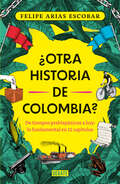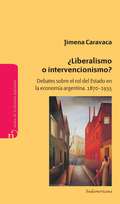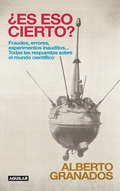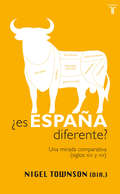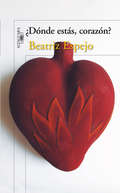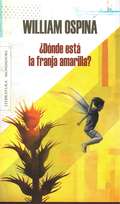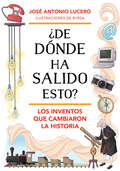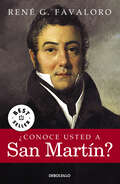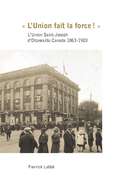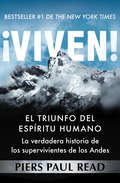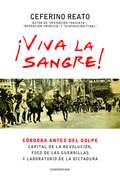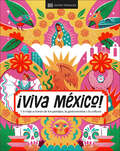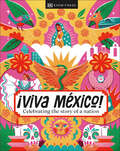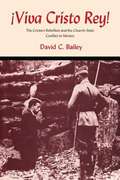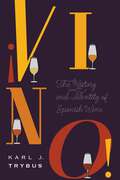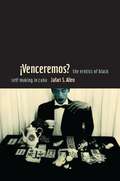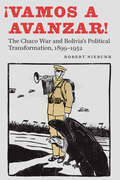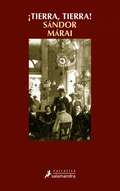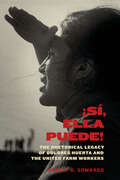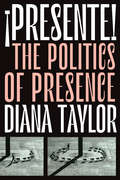- Table View
- List View
¿Podemos hacer sonar la Campana de la Libertad? (¡Arriba la Lectura!, Read Aloud Module 6 #3)
by Kyle Poling Martha RustadNIMAC-sourced textbook
¿Otra historia de Colombia?: De tiempos prehispánicos a hoy: lo fundamental en 12 capítulos
by Felipe Arias EscobarUna historia fresca y concisa de Colombia, con todo lo que hay que saber para entender nuestro pasado y los desafíos del presente Cuando creíamos que ya todo estaba dicho sobre la historia de Colombia, llega este libro para de mostrarnos que todavía hay territorios nuevos por explorar. ¿Sabías, por ejemplo, que hubo españoles que estuvieron a favor de la independencia?, ¿que la Conquista fue apoyada por comunidades indígenas?, ¿que la primera huelga obrera en el país fue liderada por una mujer?, ¿o que el gran nivel de resistencia de los ciclistas colombianos se debe a un proceso microevolutivo que data de miles de años atrás? Esto y mucho más es abordado en estas páginas por Felipe Arias Escobar, quien nos invita a recorrer el pasado desde una perspectiva distinta y a entender el origen de los desafíos que enfrentamos en la actualidad. Además de presentar un panorama general de nuestra historia, el autor incluye al final de cada capítulo sugerencias bibliográficas y audiovisuales para que los lectores puedan ampliar sus conocimientos sobre lo que es y ha sido el devenir de nuestra sociedad
¿Liberalismo o intervencionismo?: Debates sobre el rol del Estado en la economía argentina 1870-1935
by Jimena CaravacaDe la colección «Nudos de la historia argentina» dirigiga por JorgeGelman, el lugar del Estado en la economía a lo largo de más de 150años. ¿Cuál es el lugar del Estado en la economía? ¿Debe regularla o dejar queel mercado asigne los recursos? ¿Es la ley de la oferta y la demanda laque organiza de manera más eficiente la vida económica? ¿Los impuestos,deben servir para redistribuir la riqueza? ¿Por qué es importanteconsolidar una industria nacional, a quién beneficia? Estas cuestionestienen al menos 150 años de discusión en la Argentina. Jimena Caravacarecorre y analiza en estas páginas los debates que tuvieron lugar entre1870 y la crisis internacional de 1930 sobre el papel del Estado en laorganización económica del país. Revisar ese itinerario resulta hoyrevelador para saber de qué hablamos cuando hablamos de Estadointerventor, liberal o entrometido.Para la colección Nudos de la Historia argentina hemos pedido ahistoriadores de primer nivel que escriban libros sólidos pero a la vezatractivos, susceptibles de ser leídos ydisfrutados por personas interesadas en la historia, aunque carezcan deuna formación universitaria en la disciplina. Esperamos estar a laaltura del desafío.
¿Es eso cierto?
by Alberto GranadosFraudes, errores, experimentos inauditos... Todas las respuestas a tus preguntas sobre el mundo científico. Desde los albores del mundo el ser humano ha satisfecho sus ansias de conocimiento con la experimentación y la observación de su entorno para encontrar respuestas a preguntas aparentemente obvias que marcarían el rumbo de su existencia, para hacer realidad sus propios sueños o para entender el legado de los pueblos antiguos. A partir de ese impulso, de esa curiosidad inherente surgen incógnitas, teorías, fórmulas, hallazgos, experimentos... ciencia, y gracias a esta pulsión el hombre ha sido capaz de volar, de conquistar el espacio, de mejorar su calidad de vida... Pero toda cara posee una cruz y a veces el ardor científico se empaña de ambición o de fama y se convierte en generador de historias escabrosas que es mejor olvidar. Granados, autor de éxito de Leyendas urbanas, ha reunido para su «mundo curioso», un recorrido por los errores, los fraudes y las curiosidades científicas a través del tiempo, que no nos dejará indiferentes y que nos hará experimentar momentos irrepetibles. ¿Es eso cierto? demuestra que ciencia y entretenimiento son en ocasiones un binomio perfecto.
¿Es España diferente?: Una mirada comparativa (siglos XIX y XX)
by Nigel TownsonLa historia de España de los siglos XIX y XX en perspectiva comparada. El eslogan Spain is different, que llegó a simbolizar no sólo la explosión turística de los sesenta sino también la aberrante singularidad de la dictadura franquista, acabó convirtiéndose en una idea preconcebida incluso para los historiadores. Muchos de los aspectos más destacados de la historia española contemporánea, como los pronunciamientos, el anticlericalismo, la creación de la identidad nacional, la Guerra Civil o Franco, suelen verse como ejemplos de su anormalidad o peculiaridad, pero pocos historiadores han intentado realmente colocar en un marco amplio la trayectoria política, económica y social de la España de los últimos dos siglos. Desde una perspectiva explícitamente comparativa, este libro se propone averiguar si la historia de España, situada en el contexto internacional, puede considerarse representativa, retrógrada o incluso una ruptura. En otras palabras, permite, por vez primera, evaluar si España es o no diferente. En este libro participan otros cuatro reconocidos historiadores: José Álvarez Junco, María Cruz Romeo Mateo, Edward Malefakis y Pamela Radcliff.
¿Dónde estás, corazón?
by Beatriz Espejo«Hasta en el amor más perfecto, uno ama mejor y con más fuerza que el otro...»Es la primera mitad del siglo XVIII y el virrey de la Nueva España, don Baltasar de Zúñiga y Guzmán, quiere dejar su impronta en la renovación de las instituciones, por lo que decide formar el primer convento con acceso a mujeres indígenas. Por supuesto, no las indias comunes, pues su alma sigue teniendo algo de bestia, sino las hijas de los caciques, ya educadas en el castellano, en habilidades como coser, tocar algún instrumento, cantar, y que además poseen dote. Sus familias elevarán su categoría social, puesto que #tener una religiosa en la familia viste mucho#.Para dirigir el nuevo convento, don Baltasar elige a sor Petra de San Francisco. Llegan solicitudes de todas partes, que sor Petra evalúa en función del prestigio que puedan aportar las candidatas, y el recinto se va llenando de huérfanas, aristócratas sin fortuna que consiguen la dote apartes entre toda la familia, solteronas, mujeres repudiadas, hijas de caciques aún prósperos... Con este mosaico de personajes, Beatriz Espejo muestra los detalles más íntimos de cómo se forjó la Nueva España. Y como si de la visita a un museo se tratara, el lector asiste a la exposición de retratos de personajes caprichosos, engañosos, recargados, como el estilo barroco, que van mostrando sus debilidades, su doble moral, su adoración pagana con ídolos escondidos en sus celdas. Algunos encarnan los pecados capitales. Esta novela es un verdadero ejercicio artístico visual y antropológico por su deslumbrante lenguaje y gran investigación de fondo.
¿Dónde está su altar?
by Gabriel AgboUn altar es un lugar de sacrificio. Es un lugar de culto. Es donde los humanos y los espíritus se encuentran normalmente. Un altar exige sacrificios y los sacrificios atraen a Dios. Si quiere tener una relación muy cordial con Dios, debe establecer un altar y mantenerlo regularmente con sacrificio. Y doy por un hecho que usted sabe que el sacrificio de la actualidad ya no es de animales, pájaros, velas, incienso, granos y ofrendas al fuego, etc., más bien es de nuestra vida dedicada a Dios. Hoy, le ofrecemos un sacrificio agradable y de olor dulce al vivir una vida santa y dedicada. La vida que vivimos asciende a Él como un aroma dulce, agradable. Ahora, pregunto, ¿está viviendo como un sacrificio para Él? ¿Tiene un altar? ¿Tiene para su familia? ¿Donde reza? ¿Tiene un lugar y tiempo dedicado para ello? ¿Le dedica suficiente alabanza y culto? ¿Sabe que el cielo viene a esperarle a tu hora y lugar de culto habituales? ¿Es usted un altar para Él? Sí, él quiere que seamos altares móviles. ¿Y los paganos, los ocultistas, los satanistas, tienen sus propios altares? ¿Nos pueden afectar? Este es un libro interesante.
¿Dónde está la franja amarilla?
by William Ospina"En algunos de sus relatos Gabriel García Márquez habla de un hombre queestá muriendo de indigencia en el paraíso. Cualquier colombiano, rico opobre, puede hoy reconocerse allí." "Hemos hecho del más privilegiado territorio del continente unadesoladora pesadilla. Las sierras eléctricas aniquilan una naturalezaque podría salvarnos; la conquista de América prosigue con su viejorostro brutal contra los hombres y las selvas; la peste del olvido borrónuestros orígenes y nuestros sueños. Pero todos necesitamos un país. Laspáginas que siguen no son más que un esfuerzo sincero por entender loque somos: un escritor tiene el deber de ser parte de su tierra y de suépoca. Reinventar el país no puede ser tarea de unos cuantos, pero laenormidad de la labor casi exige milagros. Recuerdo entonces aquellaspalabras de Voltaire nsobre los hombres de su tiempo: 'Necesitabanmilagros: los hicieron'"
¿De dónde ha salido esto? Los inventos que cambiaron la Historia
by José Antonio Lucero¿Alguna vez te has preguntado de dónde han salido todas las cosas que nos rodean?¡En este libro encontrarás las respuestas! ¿Alguna vez te has preguntado de dónde han salido todas las cosas que nos rodean? ¡En este libro encontrarás las respuestas! ¿Desde cuándo existe el dinero? Si los fuegos artificiales se inventaron por casualidad, ¿qué buscaban sus creadores en realidad? ¿Cómo funcionan las vacunas? ¿Desde cuándo usamos la energía eléctrica en casa y por qué podemos iluminarnos con ella? Viaja a través de las principales épocas de la historia y descubre las respuestas a todas las preguntas que siempre te has hecho acerca de los grandes inventos que han cambiado el destino de la humanidad. ¿Quién lo inventó? ¿Cómo? ¿Y por qué? Con montones de datos sorprendentes e historias divertidas, este es el libro perfecto para los más curiosos de la casa y los amantes de la historia (¡y también para los que todavía no saben que lo son!). ¿Qué incluye?-Un atractivo recorrido por la historia a través del punto de vista de niños y jóvenes de cada época y personajes históricos, con referencias a la cultura popular.-Destacados, relatos, curiosidades y secciones de repaso de conocimientos para aprender disfrutando.-Preciosas ilustraciones para entender y asimilar mejor la información. Sobre el autor:José Antonio Lucero es el profesor detrás del canal educativo de YouTube La cuna de Halicarnaso, donde combina historia, cultura y docencia, sin perder de vista las referencias a la cultura pop y a los fenómenos de masas. Además de historiador y profesor, Lucero es autor de las novelas La vida en un minuto y La madrina de guerra (Ediciones B) y de ¿Por qué los primeros emojis se escribían en arcilla?, un divertido libro de historia para niños a partir de 9 años.
¿Conoce usted a San Martín?
by Rene FavaloroPublicado por primera vez en 1986, goza de una vigencia que demuestrauna vez más la lucidez del doctor René Favaloro. «Dentro de mis lecturas, ocupa un lugar preferencial el general don Joséde San Martín, con quien durante largos años hemos estado dialogando através de diversos libros, folletos y artículos. El análisis cuidadosode su vida, a mi entender, demuestra que la gran mayoría de losargentinos «civiles y militares» no la conoce en profundidad y, por elcontrario, en infinidad de ocasiones San Martín ha sido y es utilizadopara defender intereses bastardos, en especial a través de comparacionesy paralelismos, tratando de justificar desviaciones perniciosas denuestro pasado lejano y reciente.Estuve recluido durante tres semanas, rodeado de libros y apuntesrelacionados con la Gesta Sanmartiniana, varias veces leídosanteriormente. Como resultado de aquella ardua tarea nacieron estaspáginas, que sentí obligatorias por los momentos difíciles que hoy letoca vivir a nuestro país. Solo espero que contribuya a que losargentinos encontremos el camino que nos lleve a ubicarnoscorrectamente, para que no seamos engañados como tantas veces». René G.Favaloro
« L’Union fait la force! »: L’Union Saint-Joseph d’Ottawa/du Canada 1863-1920 (Amérique française)
by Pierrick LabbéEn 1863, un groupe de travailleurs originaires du Québec et domiciliés à Ottawa décident de fonder une association de prévoyance pour aider leurs prochains dans le besoin. En s’inspirant de leurs expériences respectives au sein d’associations de prévoyance québécoises, les fondateurs établissent une première société de secours mutuels canadienne-française à Ottawa : l’Union Saint-Joseph d’Ottawa. Malgré une naissance et des débuts modestes, cette association connaîtra une grande histoire. Elle deviendra l’une des plus grandes sociétés fraternelles nationales, avec des ramifications dans plus de 600 communautés canadiennes-françaises du Canada et des États-Unis. Cet ouvrage analyse la fondation de l’Union Saint-Joseph d’Ottawa et son évolution entre 1863 et 1920. Durant cette période, cette petite association locale, dont les activités visent essentiellement le secours de la classe populaire, évolue pour devenir une grande société fraternelle nationale vouée à la sauvegarde des intérêts des Canadiens français. L’essentiel de ces mutations survient à la fin du XIXe siècle, alors qu’une petite élite entreprend des réformes administratives qui changent la manière de gérer la mutualité. Cette élite en profite également pour reformuler le projet social de l’association et ses objectifs afin de transformer l’Union Saint-Joseph en un instrument de lutte pour la survivance canadienne-française. Publié en français
¡raza Si! ¡guerra No!: Chicano Protest And Patriotism During The Viet Nam War Era
by Lorena OropezaThis incisive and elegantly written examination of Chicano antiwar mobilization demonstrates how the pivotal experience of activism during the Viet Nam War era played itself out among Mexican Americans. ¡Raza Sí! ¡Guerra No! presents an engaging portrait of Chicano protest and patriotism. On a deeper level, the book considers larger themes of American nationalism and citizenship and the role of minorities in the military service, themes that remain pertinent today. Lorena Oropeza's exploration of the evolution, political trajectory, and eventual implosion of the Chicano campaign against the war in Viet Nam encompasses a fascinating meditation on Mexican Americans' political and cultural orientations, loyalties, and sense of status and place in American society.
¡ZUM! La historia del snowboard (¡Arriba la Lectura!, Level M #72)
by Lisa TrumbauerSi te gusta la nieve, tal vez te guste practicar snowboard. ¡Lee sobre este divertido deporte! NIMAC-sourced textbook
¡Y hasta aquí puedo leer!
by Mayra Gómez KempDespués de ser galardonada con el premio más importante de la Academia de las Ciencias y las Artes de Televisión por su larga y fructífera trayectoria profesional, Mayra Gómez Kemp, la presentadora más famosa de la pequeña pantalla, vuelve a la primera línea de la actualidad con un libro de memorias en el que lo cuenta todo: desde el exilio que vivió en su infancia y su posterior viaje a España hasta sus comienzos como actriz y cantante, pasando por todas sus vivencias y anécdotas en el Un, dos, tres, el mítico programa que la convirtió en la primera mujer presentadora de concursos del mundo y en una de las estrellas más entrañables de nuestro país, y, finalmente, el acto de coraje y valentía con el que enfrentó su lucha contra el cáncer.La espontaneidad de Mayra, su cercanía, simpatía, humor y risa han cautivado a generaciones de espectadores para los que, semana tras semana, acabó por convertirse en una más de la familia. Ejemplifica la fuerza de voluntad de una mujer que, en un mundo de hombres, supo defender su integridad y profesión llegando a lo más alto, sin doblegarse nunca a los deseos de los demás. Sus memorias son un canto a la vida, una carta de amor a la profesión y un mensaje positivo de superación ante la adversidad.
¡Viven!: El triunfo del espíritu humano
by Piers Paul ReadBestseller #1 de TheNew York Times: La verdadera historia de un equipo de rugby que recurre a lo inimaginable cuando su avión se estrella en los Andes. Reinaba el buen ánimo cuando el Fairchild F-227 despegó desde Mendoza, Argentina, con rumbo a Santiago, Chile. Había cuarenta y cinco pasajeros a bordo, entre ellos un equipo de rugby amateur uruguayo y los amigos y parientes de los jugadores. El cielo estaba despejado ese viernes 13 de octubre de 1972 y, a las 15:30 de la tarde, el piloto del Fairchild anunció que se encontraban a 15.000 pies de altura. Sin embargo, un minuto después, la torre de control de Santiago perdió todo contacto con la aeronave. Chilenos, uruguayos y argentinos buscaron el avión durante ocho días pero había nevado con intensidad sobre los Andes y las posibilidades de encontrar los restos eran escasas. Diez semanas más tarde, un campesino vio a dos hombres con aspecto harapiento haciendo señas, desesperados, desde el otro lado de un río. Les tiró un pedazo de papel y un bolígrafo envueltos en un pañuelo y los hombres enseguida le devolvieron una nota que leía: &“Venimos de un avión que cayó en las montañas&”. Dieciséis pasajeros sobrevivieron. Acamparon en el fuselaje del avión en medio de la naturaleza gélida de los Andes, donde soportaron temperaturas heladas, peligrosas lesiones, una avalancha, y hambre extrema. Cuando comenzaron a acabarse las escasas provisiones de alimento y, luego de oír en la radio que habían logrado armar, que los equipos de rescate habían cesado su búsqueda, las esperanzas de los pasajeros se empezaron a desvanecer. Con el fin de salvar sus propias vidas, estos tuvieron que no sólo mantener la fe, sino que también debieron tomar una imposible decisión: comer o no la carne de sus amigos que habían muerto. Una historia de resiliencia, determinación, y el espíritu humano, ¡Viven! es un relato conmovedor de una historia de supervivencia desgarradora.
¡Viva la sangre!: Córdoba antes del golpe
by Ceferino ReatoCon esa capacidad de ofrecer siempre información reveladora y sabernarrar como un verdadero novelista, Ceferino Reato ha escrito un libroque resume como ningún otro la tragedia de los setenta. Con su estilo que ya es una maraca #información reveladora, narraciónatrapante-- Ceferino Reato ha escrito un libro que resume como ningúnotro la tragedia de los setenta. Córdoba fue el gran escenario deaquella época; allí, la revolución socialista pareció al alcance de lamano, impulsada tanto por una original alianza entre obreros yestudiantes como por las guerrillas de Montoneros y el EjércitoRevolucionario del Pueblo. Al frente del gobierno por tercera vez, elgeneral Juan Perón fue el primero en darse cuenta de la amenaza queconstituía la "patria socialista" para la "patria peronista", y lanzóuna fuerte ofensiva contra la Córdoba rebelde. Luego de su muerte, esalucha se volvió salvaje, cruel. ¡Viva la sangre! se desarrolla entreagosto y octubre de 1975, mientras los militares avanzaban hacia elgobierno y Córdoba anticipaba cómo sería la represión ilegal de ladictadura con el surgimiento del Comando Libertadores de América.Las violaciones a los derechos humanos no comenzaron con el golpe del 24de marzo de 1976 y Córdoba lo confirma: 69 personas fueron desaparecidasdurante los últimos seis meses del gobierno de Isabel Perón. También lasguerrillas sumaron a la tragedia con sus bombas, sus secuestros y susmuertes. Reato arremete contra un tema tabú en la Argentina: da aconocer por primera vez de manera precisa las verdaderas cifras dedesaparecidos y muertos de la dictadura, tanto en Córdoba como en todoel país, un aporte invalorable a la necesaria construcción de la verdadhistórica.Ya desde el título, que evoca las temerarias consignas de la época, ¡Viva la sangre! muestra desde adentro la banalidad con la cual tantaspersonas mataron y murieron en una época que aún continúa presente.Foto de tapa: Cordobazo, 29 de mayo de 1969. Archivo General de laNación Dpto. Doc. Fotográficos. Buenos Aires, Argentina.
¡Viva México! (Spanish Edition)
by DK EyewitnessCuna de civilizaciones tan antiguas como el tiempo, con 440 playas, más de 100 pueblos mágicos, impresionantes sitios arqueológicos y bulliciosas ciudades, México es un país con una gran cultura y tradición que merece ser celebrado.Sumérgete en la esencia de México y descubre la riqueza cultural y la diversidad de este maravilloso país: sus tradiciones indígenas milenarias, las delicias culinarias reconocidas a nivel mundial por su exquisito sabor, los festivales vibrantes llenos de energía que rebosan de color y alegría…Tanto si planeas tu primer viaje a México como si solo deseas aprender sobre su cultura e historia, ¡Viva México! te enseña todo lo que siempre quisiste saber sobre el país del Día de Muertos.Pasa las páginas de este libro inspiracional y explora la riqueza culinaria de cada región, deléitate con los sabores de sus bebidas y platillos, descubre su arquitectura, sorpréndete con su arte y el ciclo cambiante de las diferentes fiestas y celebraciones, visita encantadoras poblaciones indígenas llenas de color y recorre asombrosos paisajes naturales. México tiene mucho que ofrecer, ¡desde playas de arena blanca bañadas por el Caribe y montañas revestidas de selva a impresionantes templos precolombinos y ciudades coloniales!Prepárate para disfrutar y celebrar todo lo que hace a México un país tan especial y conoce los fuertes vínculos que unen a su gente, ya sea la importancia de la familia, el aprecio de la comida picante o simplemente el deseo de continuar la plática por horas después de que la comida haya terminado. ¡Viva México! ¡Viva México lindo y querido! —-----------------------------There's so much to love about Mexico. Indigenous traditions stretching back millennia; colourful cuisine that's loved the world over; and vibrant festivals bursting with joyful energy. Mexico is a country worth celebrating - and that's exactly what ¡Viva Mexico! is all about.Within its pages, you'll discover the rich diversity of this vast country. Uncover its varied natural landscapes, which stretch from white-sand beaches to jungle-cloaked mountains; explore its vibrant cuisine and how it differs greatly from region to region; and learn about its ever-changing cycle of colourful feasts and fiestas. The book also covers Day of the Dead traditions, how staples of Mexican food have changed as they've travelled the globe, and how pioneering filmmakers continue to influence the world of cinema.Throughout, you'll unearth the unshakable ties that link this diverse country together, whether it's the importance of family, a love of chilis or simply the desire to keep chatting around the table long after dinner has finished. So, get ready to learn what makes Mexico so special - ¡viva Mexico! Long live Mexico!
¡Viva Mexico!
by DK EyewitnessThere's so much to love about Mexico. Indigenous traditions stretching back millennia; colourful cuisine that's loved the world over; and vibrant festivals bursting with joyful energy. Mexico is a country worth celebrating - and that's exactly what ¡Viva Mexico! is all about.Within its pages, you'll discover the rich diversity of this vast country. Uncover its varied natural landscapes, which stretch from white-sand beaches to jungle-cloaked mountains; explore its vibrant cuisine and how it differs greatly from region to region; and learn about its ever-changing cycle of colourful feasts and fiestas. The book also covers Day of the Dead traditions, how staples of Mexican food have changed as they've travelled the globe, and how pioneering filmmakers continue to influence the world of cinema.Throughout, you'll unearth the unshakable ties that link this diverse country together, whether it's the importance of family, a love of chilis or simply the desire to keep chatting around the table long after dinner has finished. So, get ready to learn what makes Mexico so special - ¡viva Mexico! Long live Mexico!
¡Viva Cristo Rey! The Cristero Rebellion and the Church-State Conflict in Mexico
by David C. BaileyBetween 1926 and 1929, thousands of Mexicans fought and died in an attempt to overthrow the government of their country. They were the Cristeros, so called because of their battle cry, ¡Viva Cristo Rey!—Long Live Christ the King! The Cristero rebellion and the church-state conflict remain one of the most controversial subjects in Mexican history, and much of the writing on it is emotional polemic. David C. Bailey, basing his study on the most important published and unpublished sources available, strikes a balance between objective reporting and analysis. This book depicts a national calamity in which sincere people followed their convictions to often tragic ends.
¡Vino!: The History and Identity of Spanish Wine (At Table)
by Karl J. Trybus¡Vino! explores the history and identity of Spanish wine production from the mid-nineteenth century to today. Nineteenth-century infestations of oidium fungus and phylloxera aphids devastated French and Italian vineyards but didn&’t extend to the Iberian Peninsula at first, giving Spanish vintners the opportunity to increase their international sales. Once French and Italian wineries rebounded, however, Spanish wine producers had to up their game. Spain could not produce only table wine; it needed a quality product to compete with the supposedly superior French wines. After the Spanish Civil War the totalitarian Franco regime turned its attention to Spain&’s devastated agricultural sector, but the country&’s wine industry did not rebound until well after World War II. In the postwar years, it rebranded itself to compete in a more integrated European and international marketplace with the creation of a new wine identity. As European integration continued, Spanish wine producers and the tourism industry worked together to promote the uniqueness of Spain and the quality of its wines. Karl J. Trybus explores the development of Spanish wine in the context of national and global events, tracing how the wine industry has fared and ultimately prospered despite civil war, regional concerns, foreign problems, and changing tastes.
¡Venceremos?: The Erotics of Black Self-Making in Cuba
by Jafari S. AllenPromoting the revolutionary socialist project of equality and dignity for all, the slogan Venceremos! (We shall overcome!) appears throughout Cuba, everywhere from newspapers to school murals to nightclubs. Yet the accomplishments of the Cuban state are belied by the marginalization of blacks, the prejudice against sexual minorities, and gender inequities. Venceremos? is a groundbreaking ethnography on race, desire, and belonging among blacks in early-twenty-first-century Cuba, as the nation opens its economy to global capital. Expanding on Audre Lorde's vision of embodied, even "useful," desire, Jafari S. Allen shows how black Cubans engage in acts of "erotic self-making," reinterpreting, transgressing, and potentially transforming racialized and sexualized interpellations of their identities. He illuminates intimate spaces of autonomy created by people whose multiply subaltern identities have rendered them illegible to state functionaries, and to most scholars. In everyday practices in Havana and Santiago de Cuba--including Santeria rituals, gay men's parties, hip hop concerts, the tourist-oriented sex trade, lesbian organizing, HIV education, and just hanging out--Allen highlights small but significant acts of struggle for autonomy and dignity.
¡Vamos a avanzar!: The Chaco War and Bolivia's Political Transformation, 1899–1952
by Robert NiebuhrIn ¡Vamos a avanzar! Robert Niebuhr argues that despite widespread corruption, a lack of skills, and failed policies, Bolivian leaders in the first half of the twentieth century created a modern state because of the profound role of warfare over the Chaco. When President Daniel Salamanca hastily thrust his isolated and poverty-stricken country into the devastation of the Chaco War against Paraguay in 1932, he unleashed a number of forces that had been brewing inside and outside of Bolivia, all of which combined to bring Bolivia a truly modern national identity and state-building program. This conflict was the defining moment whereby rhetoric and populism took on a broader meaning among the newly mobile populace, especially the Indigenous war veterans, as the Bolivians proclaimed, ¡Vamos a avanzar! (Let&’s move forward!). With the final revolution of 1952, politics in Bolivia became more modern than they had been in the period of the Chaco War or during the populist leanings of all post-1899 governments. Niebuhr offers a fresh contribution, showing the importance of the turbulent populist politics of the period after 1899 and the significance of the Chaco War as the most influential revolutionary event in modern Bolivian history.
¡Tierra, tierra!
by Sándor MáraiSegunda obra autobiográfica de Sándor Márai tras Confesiones de un burgués, éste es el libro más íntimo y desgarrador de todos los escritos por el gran autor húngaro. La clarividencia de su visión política, la profundidad de su análisis histórico, su perspicacia psicológica y su inteligente ironía confluyen en un relato apasionante en el que la Historia se convierte en un asunto personal, en una realidad palpable que traza ineludiblemente el destino de las personas. Escrita veinte años después de los acontecimientos evocados, ¡Tierra, tierra! sitúa al lector como testigo directo de la agonía de la cultura europea, del proceso brutal de bolchevización emprendido por Rusia y de la indiferencia de Occidente hacia la suerte de cien millones de europeos de esa «periferia» que formaba el antiguo imperio austrohúngaro. Primero, el regreso a Budapest, su casa reducida a escombros, los seis mil libros de su valiosa biblioteca desaparecidos. Después, la terrible constatación de la nueva era que se iniciaba: «Los que llevaban los uniformes eran iguales porque hacían lo mismo: ejecutar el Terror con eficacia. [...] De nuevo se empezaba a perseguir en nombre de la Única Idea Salvadora.» Más tarde, las críticas al sistema represor soviético y su saqueo institucionalizado. Y por último, al comprender que su mera presencia, aunque silenciada por la censura, avalaba el régimen dictatorial impuesto en su país, la decisión del exilio, el precio a pagar para que «no puedan comprarme como individuo». En el verano de 1948, el escritor húngaro aceptó una invitación para participar en unas jornadas literarias en Suiza. El telón de acero todavía no estaba completamente cerrado y él aún resultaba políticamente indiferente a los comunistas. Era su última oportunidad de conseguir un pasaporte para abandonar el país. Márai salió de Hungría con su mujer y su hijo adoptivo para no volver nunca más. A partir de entonces su única patria sería la lengua húngara. La crítica ha dicho...«Unos espléndidos diarios, que se convertirían en lo mejor de su extensa obra narrativa.»Mercedes Monmany, ABC «Estas memorias son un canto de cisne a ese perdido "mundo de ayer" víctima de los totalitarismos y una bella, melancólica reivindicación de lo esencial.»Juana Salabert, La Razón «Un libro fundamental.»Marcos-R. Barnatán, El Mundo «Los muchos lectores que Márai tiene en España están de enhorabuena: tienen ante sí uno de los mejores libros de su escritor. Un clásico.»Monika Zgustova, Babelia «Enorme agudeza intelectual, enorme sensibilidad. [...] Nos da ese aliento de absoluta seducción que respira su literatura.»Diego Doncel, EL cultural «Un testimonio autobiográfico imprescindible. Ahora ya estamos seguros de que lo mejor de Sándor Márai no son sus novelas.»Pablo Martínez Zarrachina, Territorios «Envuelto en una prosa soberbia (y soberbialmente traducida), salpicada de poesías.»Agata Orzeszek «El libro de Sandor Marai, es más que unas memorias, es más que un tratado de historia: es la evolución de la vida de un pueblo, de un hombre, un escritor que mira cómo se desmoronan años de cultura, como se desmorona una sociedad, y como en tantas ocasiones se desmorona el mismo ser humano.»Rosario Bofill, El Ciervo
¡Sí, Ella Puede!: The Rhetorical Legacy of Dolores Huerta and the United Farm Workers (Inter-America Series)
by Stacey K. SowardsA &“valuable&” analysis of the speeches, letters, and interviews of the United Farm Workers cofounder and Latina activist (Aztlán: A Journal of Chicano Studies). Since the 1950s, Latina activist Dolores Huerta has been a fervent leader and organizer in the struggle for farmworkers&’ rights within the Latina/o community. A cofounder of the United Farm Workers union in the 1960s alongside César Chávez, Huerta was a union vice president for nearly four decades before starting her own foundation in the early 2000s. She continues to act as a dynamic speaker, passionate lobbyist, and dedicated figure for social and political change, but her crucial contributions and commanding presence have often been overshadowed by those of Chávez and other leaders in the Chicana/o movement. In this new study, Stacey K. Sowards closely examines Huerta&’s rhetorical skills both in and out of the public eye and defines Huerta&’s vital place within Chicana/o history. Referencing the theoretical works of Pierre Bourdieu, Chela Sandoval, Gloria Anzaldúa, and others, Sowards closely analyzes Huerta&’s speeches, letters, and interviews. She shows how Huerta navigates the complex intersections of race, ethnicity, gender, language, and class through the myriad challenges faced by women activists of color. Sowards&’s approach to studying Huerta&’s rhetorical influence offers a unique perspective for understanding the transformative relationship between agency and social justice.
¡Presente!: The Politics of Presence (Dissident Acts)
by Diana TaylorIn ¡Presente! Diana Taylor asks what it means to be physically and politically present in situations where it seems that nothing can be done. As much an act, a word, an attitude, a theoretical intervention, and a performance pedagogy, Taylor maps ¡presente! at work in scenarios ranging from conquest, through colonial enactments and resistance movements, to present moments of capitalist extractivism and forced migration in the Americas. ¡Presente!—present among, with, and to; a walking and talking with others; an ontological and epistemic reflection on presence and subjectivity as participatory and relational, founded on mutual recognition—requires rethinking and unlearning in ways that challenge colonial epistemologies. Showing how knowledge is not something to be harvested but a process of being, knowing, and acting with others, Taylor models a way for scholarship to be present in political struggles.

